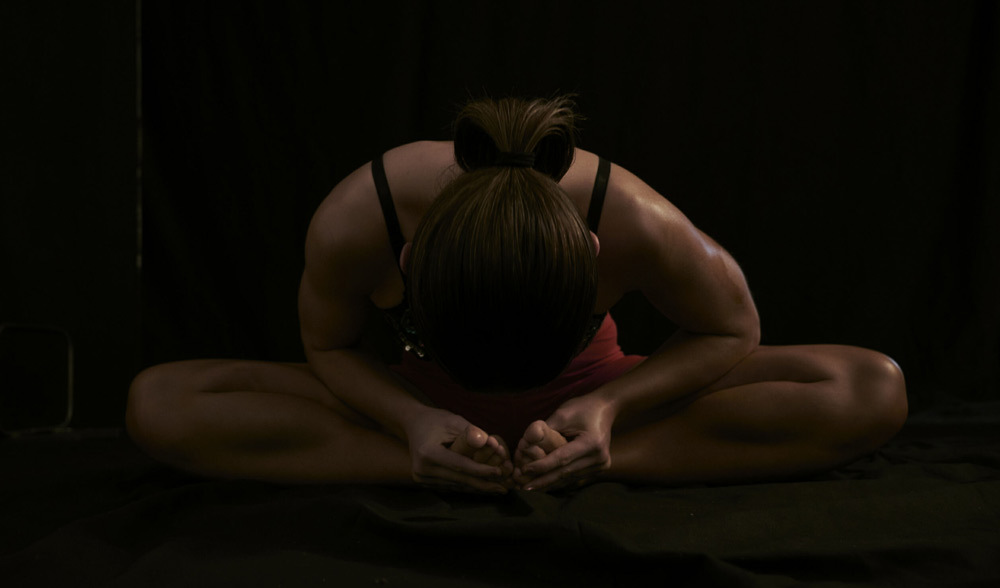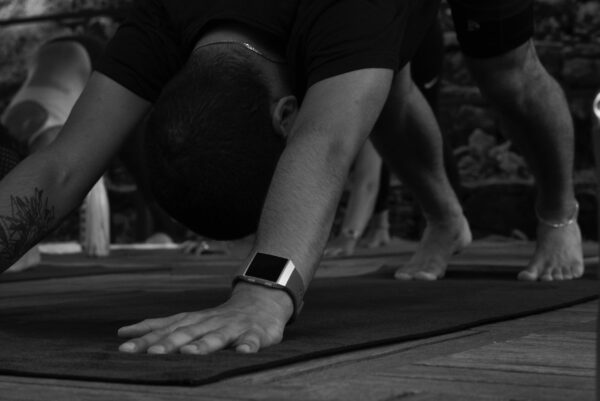FG founder Michele Pernetta shares her top tips for relieving and preventing neck pain.
With our ever increasing need to be on hand held tablets, computers and phones, as well as in cars, at desks, and holding our children, our upper back and neck muscles are nearly always under pressure, so people are suffering from neck tension more than ever before. Even healthy activities such as walking our dogs, as well as many sports that encourage forward bending such as cycling, running and the gym, can create postural habits that can cause neck tension. The head weighs about 8lbs, which if you imagine 8 bags of sugar is quite a weight for the neck and upper back muscles to hold, especially if it is being held in front of the body, rather than on top of it.
Great posture helps, so the upper back is not rounded, shoulders down and back, sternum lifted thereby bringing the head above the pelvis and in line with spine. A natural small curve in the back of the neck also allows the discs to maintain their cushioning activity and preventing disc compression. Yoga is unsurpassed to correct postural issues at source and bring back the body’s natural alignment.
Here are some tips for neck tension:
Tips:
1. Stand against a wall with your heels hips shoulders and back of the head against the wall and draw the chin slightly down to elongate the back of your neck. This will remind you of where the head should be in relationship to the body as we do tend to let the head come forward of the shoulders, creating tension and tightness in the muscles at the back of the neck and this can set up a situation where muscles are more easily pulled when sleeping wrong or lifting or moving around in the day. So, it’s good to try to remember to bring the head back in space so that it sits above the body and only a very small natural curve in the back of the neck. Lying flat on the floor does something similar although when standing one can feel a little more easily how we tend to throw the head forward of the body.
2. Traction is one of the most important things to bring to the vertebra of the neck. Yoga is excellent at providing opportunities for traction in poses such as Prasarita, practised with the legs about 4 feet apart and the body hanging between the legs (bend knees if stiff!) with the neck relaxed allows some space and stretching of the muscles on the back of the neck. It’s nice to just shake the head “no” and nod “yes” in this position to ease and relax there and relieve pressure on discs.
3. Tight muscles can create pain, so massage is very important. If one cannot get to a good massage therapist often enough you can buy these incredible balls - they are about the size of a tennis ball (or in fact you can use two tennis balls) and lie on your back and place the ball under the base of the skull and any painful areas under the shoulders, around the trapezius muscles and just massage wherever it is tight and painful. Spend a good 10 minutes doing this every day and it is incredible what can be achieved.
4. Ayurveda, the Indian health system that dates back thousands of years, is an incredible tool for all kinds of physical problems. I have found their practice of Abhyanga oil massage to be of enormous help for my neck. it involves rubbing oil (sesame oil is incredibly good) all over the body especially the neck, jaw and even your head if you have time and then waiting 15 minutes before having a hot bath or shower. the oil calms the nerves in the body reducing pain and helps joint problems. Also oiling the soles of the feet benefits the whole body including the neck. I know this sounds strange but do have a look on the Internet or videos on YouTube. I do this once a week and make sure I oil my neck and jaw and all the areas around the shoulders thoroughly.
5. Travelling always places a strain on the neck with the lifting of heavy bags and sleeping in cramped positions. I’m not a huge fan of the neck pillows because they encourage us to sleep with the head cranked down on one side, but if you are going to sleep then it is good to use one. I prefer to turn it round and have the thick part under the chin and rest with the head straight forward rather than to one side.
6. A lot of neck tension comes not from the neck but from the muscles in the upper back, shoulders trapezius, rhomboids - these are pulling on the neck muscles so yoga stretching of these muscles - as well as strengthening of the supporting muscles and mobilisation of the upper spine - all contribute to relieving and resolving neck issues. A weak neck is very vulnerable to injury so strengthening the neck muscles in yoga has resolved many a person’s chronic neck issues. Strengthening, stretching, traction and working the whole body including shoulders, upper back and spine to improve posture.
6. Magnesium can really help to relax chronically contracted muscles, so a good magnesium supplement can help.
7. Sleeping on a very thin pillow - most Ayurvedic and neck and spine specialists suggest you sleep on an extremely thin pillow with most of the thickness under the neck, not under the head, or buy one of those Tempur pillows that has the curve under the neck which helps to create traction.
8. A problem isn’t usually a neck problem it’s a whole-body problem, which is why yoga is so good as it addresses all the muscles, the strength, the flexibility and the elasticity of the whole body, so whatever the issue it will always help.

